Bucks Plan Envisions Arena Streetcar
$1 billion plan for new arena and other development would transform Park East land and tear down Bradley Center.
Plans for the new Milwaukee Bucks arena include the Milwaukee Streetcar, according to Michael Fascitelli, a developer and team investor who is the “quarterback” of the $1 billion plan to construct a new basketball facility and ancillary development downtown.
“We are planning a streetcar at the plaza at this time,” Fascitelli said in answer to my question at the unveiling of the arena plans at the BMO Harris Bradley Center Wednesday morning.
The “Plaza” would be a 60,000 square foot open space to be constructed on the block bounded by N. 4th St., N. Old World Third St., and W. Highland and W. McKinley avenues, where a city-owned parking structure would be demolished. The Plaza would have bars, restaurants, a water wall and outdoor fire pits. According to a press release from the team, provided by Mark Rosenberg, Bucks Public Relations Manager, the “dynamic entertainment live block will serve as both arena forecourt and community living room. This will be the year-round destination that draws the people of the region together for unforgettable experiences and a place people will love to gather for generations to come.”
Plans are to close N. 4th St. to vehicular traffic to accommodate the plaza, which is to be located immediately east of the new arena. Running a streetcar line up N. 4th St. would allow easy access to the facility for transit users. The team also envisions the arena plan to include “entertainment, commercial, retail, residential and a practice facility” for the team, according to Brad Clark, the senior designer of Populous, a Kansas City firm that has produced over 2,000 projects over three decades, including dozens of sports facilities worldwide.
“It’s more than an arena — it’s a development — a bigger and broader vision,” Clark said. The development will “express the heritage of the community,” will “be ‘warm’ in materials,” and will have a transparent facade. “Selectively placed glass and moments of transparency throughout the building open views from within to Milwaukee’s skyline,” the team reports. We’ll be able to wave at Milwaukee County Executive Chris Abele in his new apartment high in the Moderne.
According to the team press release, “the arena design evokes Wisconsin’s natural beauty and Milwaukee’s rich heritage of industry and craftsmen, with expressive structure, transparency and fluid forms inspired by the rivers, lakes and forests of the region.”
Once constructed, the old BMO Harris Bradley Center, immediately to the south, would be razed, leading to further development of the northwest corner of downtown.
“The proposed site,” which includes the current arena location, according to the team, “primarily sits between [N.] Fourth Street and [N.] Sixth Street from [W.] State Street to [W.] McKinley Avenue.” The location will “seamlessly link with active development on all sides, including Old World Third Street, Schlitz Park, The Brewery, the Milwaukee riverfront, Water Street and the Wisconsin Center.”
The arena, and eventual development expected to occur in the area, would take over a decade to complete, with the facility itself requiring about two years of construction time. “We expect to have a shovel in the ground by early fall,” said Fascitelli. He was joined on stage by Bucks President Peter Feigin, Clark, Mark Kaminski of HNTB, and Greg Uhen of Eppstein Uhen Architects, the local design partner.
Uhen spoke “as the Milwaukee guy here,” and complimented the team’s out-of-town owners for their vision. This will be a “model” arena, he said, echoing Fascitelli’s comment that he is building for “2020 and beyond.” Uhen reminded the audience that the proposed site was for decades an elevated freeway that separated downtown from adjoining neighborhoods. “The scale of the project allows us to develop multiple blocks in a cohesive fashion,” to create a “connected neighborhood,” that would operate “24/7/365,” he noted.
It would connect “The Brewery, Bronzeville, Schlitz Park and the Beerline” districts. “It begins to fill the area with a scale that is doable,” he said.
Fascitelli added, “you need more than an arena, you need residents,” citing the new Nationwide Arena in Columbus as a successful integration of a facility and catalytic development in what was a formerly disused location. The Arena District is now said to be downtown Columbus’s most popular neighborhood.
The visual presentation consisted of three display boards showing the proposed new building and the development it hopes to spawn. The renderings were an “early, preliminary interpretation,” Clark, of Populous, said. No streetcar tracks could be seen in the rendering of the plaza, however.
Feigin said the renderings would make it easier for the Bucks to present their plans to stakeholders, including members of the legislature and other bodies. “Optics becomes reality,” he said.
“We continue to work with our local and state partners to arrive at a viable plan. The collective effort will create a ripple effect of growth, development and transformation for the entire community and region,” Feigin said in his press statement.
Photos from the Press Conference
Arena Renderings
More about the Milwaukee Streetcar
For more project details, including the project timeline, financing, route and possible extensions, see our extensive past coverage.
- Another Streetcar Collision - Jeramey Jannene - Jun 27th, 2025
- Streetcar Hit By Apparent Red Light Runner - Jeramey Jannene - Jun 16th, 2025
- Streetcar Will Run On Consolidated Route During Summerfest - Jeramey Jannene - Jun 11th, 2025
- City Hall: Milwaukee Must Replace Failing Streetcar Switches - Jeramey Jannene - Feb 24th, 2025
- Streetcar Confronts Limited Funding, Operations Challenges - Evan Casey - Jan 22nd, 2025
- Council Kills Streetcar’s ‘Festivals Line’ - Jeramey Jannene - Jul 31st, 2024
- Streetcar Will Use Festivals-Oriented Route Through Summer - Jeramey Jannene - Jul 9th, 2024
- The Hop’s Lines Will Merge For Easier Summerfest Service - Jeramey Jannene - May 30th, 2024
- Streetcar Begins Daily Service To The Couture, BRT Will Soon Follow - Jeramey Jannene - Apr 11th, 2024
- Milwaukee’s Three Streetcar Extensions Need Mayoral Direction - Jeramey Jannene - Nov 8th, 2023
Read more about Milwaukee Streetcar here
Plenty of Horne
-
Villa Terrace Will Host 100 Events For 100th Anniversary, Charts Vision For Future
 Apr 6th, 2024 by Michael Horne
Apr 6th, 2024 by Michael Horne
-
Notables Attend City Birthday Party
 Jan 27th, 2024 by Michael Horne
Jan 27th, 2024 by Michael Horne
-
Will There Be a City Attorney Race?
 Nov 21st, 2023 by Michael Horne
Nov 21st, 2023 by Michael Horne


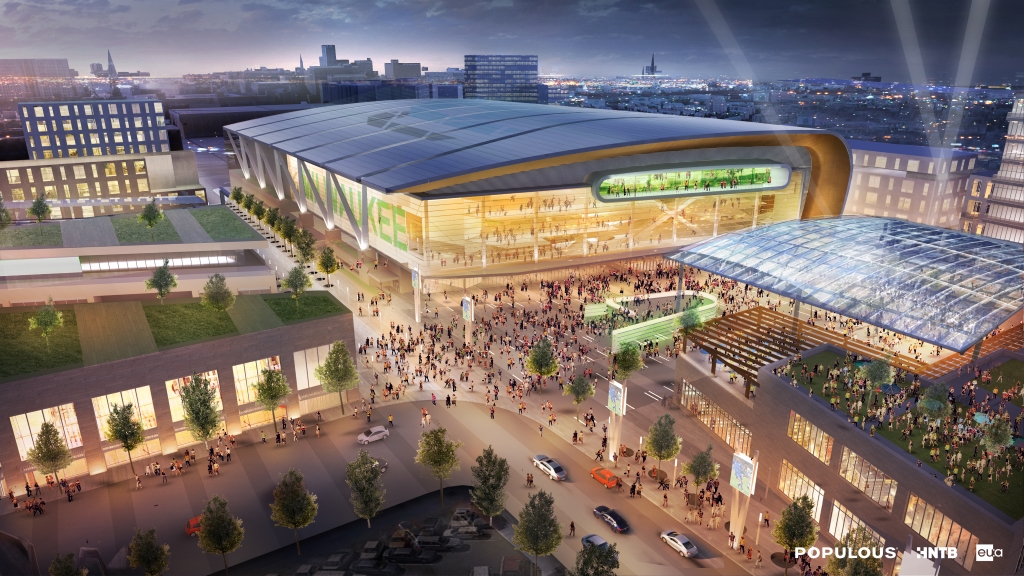
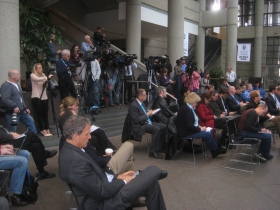
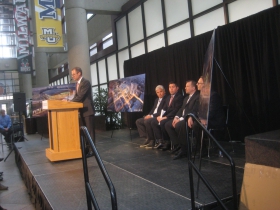
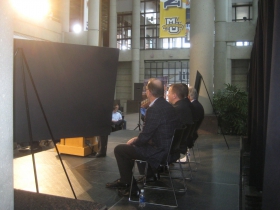
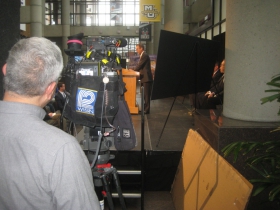
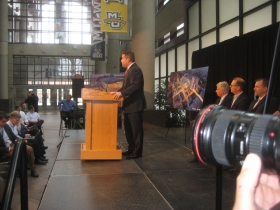
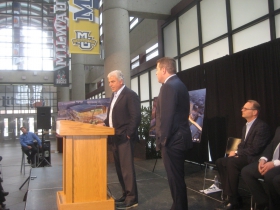
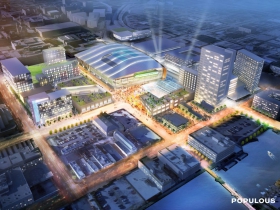
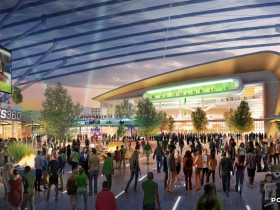
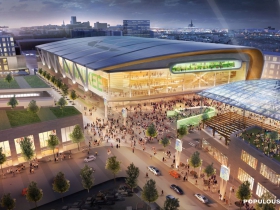




















Neato.
First, the plaza idea is okay if it isn’t permanent and 4th street can be used when the Bucks or another “special event” isn’t going on (which most definitely will be the case) Otherwise, it is useless space for a number of days out of the year and reduces access to other non-Buck related businesses in the area (namely Turner Hall). Are the bars and restaurants going in this “dynamic entertainment live block ” tax-exempt as well? Great, they have a leg up over the existing tax paying establishments already in existence in the immediate area. If not, what’s the point of saturating an already pretty saturated market? Forget bars and restaurants if you don’t put more housing in the immediate area so you have people to patron them when events aren’t going on. I’m not talking about the kind that caters exclusively to people who can afford $1,300 a month studio apartments, like the ones that have gone up at the North End recently down the street. You know, something for somebody who makes double the median income in Milwaukee can reasonably afford.
Secondly, the parking structures to be destroyed are used for many things other than Buck related uses (MATC parking, parking for the businesses in the area and the Milwaukee Theater/Panther Arena) and demolition/replacement will drive up the cost of the project.
Don’t get me started on the funding mechanism for this “year-round destination that draws the people of the region together for unforgettable experiences and a place people will love to gather for generations to come.”
Very beautiful concept, and also an all inclusive design. Bravo Bucks! While there are of course details to iron out like transit i.e. the reason for this piece, but also impact on other businesses in the area. I am really happy that Columbus, OH was included in this piece because their Arena District is a perfect example of what we could have. Ohio became my home away from home when I chose to go to college outside of Columbus, OH. I started in the Fall of 2007 and at this point, only the Arena existed in the developing Arena District. Bars had been planned and apartments were about to go in, but for a pedestrian, unless you were going there for a sports event, there was not much to do. By the time I graduated in 2012, the area was booming. Nearly all of the undeveloped land around the arena had been built up and the Arena District turned into a hot spot people not only visited, but lived in. It was also one of the first catalytic projects to bring residents into the central business district just a block or two away. As I was graduating, a series of new projects were starting, including the only remaining link between the Arena District, the Convention Center, and the booming Short North neighborhood just the the east of the Arena District. I would love to see the same type of development made here in Milwaukee, and creating our own Arena District is a great plan for the future.
@Sam…. what’s wrong? So… you don’t like the idea?
I believe a heavy dose of skepticism is warranted. Fascitelli, the development ‘Quarterback’ was the CEO of Vornado, one of the largest Real Estate Investment Trusts in the country. I am not very excited at the prospect of a REIT approach to developing this space. REITs and large format developers are driven by high IRR requirements and usually look for non-recourse financing. To achieve these things, they will have to cater to National chains to fill out their retail space as they are the only folks who can afford the high rents needed. I am not thrilled at the prospect of dumping a bunch of chain restaurant and bars into an area that already has thriving local establishments.
Having been to University of Phoenix stadium and the Staples center, they were developed with the exact types of retailers that I am worried about these guys courting. A quick perusal of Columbus’s Arena District shows the same types of tenants. If they can draw thousands of additional residents to the area, then I might not worry as much about competition between existing businesses. But as someone in the CRE industry, I have yet to see a large scale development such as these guys are proposing do much to enhance the character of the area wherever they go. Bringing in businesses one can find in every other large metro? No thank you.
I would expect that the City, County, and State would require all of the ancillary development to be on the property tax rolls, but who knows. There is a chance tax payers could get hosed.
Guys like @Sam walk around with aluminum foil hats yelling about the evil 1%ers. Just ignore them
“I have yet to see a large scale development such as these guys are proposing do much to enhance the character of the area wherever they go.”
Ha, ok. Over 1 billion dollars including a state of the art stadium wont enhance the character of the beautiful parking lot that exists there today.
“but who knows. There is a chance tax payers could get hosed.”
Wow, very insightful!
Will the $1 billion price tag make this a harder sell, even after this press conference and release of renderings?
Well the 1 billion isn’t what they are requesting from the State. The State, county, City will most likely be on the hook for about 250 million. I would put the 1 billion on the lower end of eventual investment because it does not include the private ancillary development. i.e. Hamme has mentioned spending 80 million to locate his headquarters downtown. With a myriad of local business owners buying into Bucks ownership I would expect them to invest as well, if not directly than by moving offices to the Bucks commercial development
I know Will. But people hear a billion dollars, and it sounds like a hell of a lot of money (which it is). And it’s a lot more than what had been talked about prior to yesterday.
The 1 billion has always been the number. Actually, Lasry mentioned that it could get as high as 1.5. As it stands now, Stadium=500, ancillary=500
Oh OK. I guess it didn’t seem that way because whenever I read something about the new arena, I feel like the only figure mentioned was the cost of the arena, not arena plus ancillary.
Different Sam here. While the renderings look very nice, and we could definitely use more pedestrian oriented public space downtown, I can’t help feeling like I’m watching a variation of the Simpson’s monorail episode.
There are a ton of questions that need to be answered about this project that releasing these flashy renderings just seems to serve to distract from:
-How will we pay for it? And how will that affect our ability to do things like pave roads, keep parks up, pay police, fund schools, deal with foreclosures and homelessness, etc?
-How are we going to make sure that the public gets a good return on investment and doesn’t just get stuck with all of the risks? If the public is directly subsidizing the new arena shouldn’t we directly receive some of the profits from it?
-How will this arena be “the year-round destination that draws the people of the region together for unforgettable experiences and a place people will love to gather for generations to come” when the current arena is only one generation old and already “needs” to be replaced?
-How will this affect the rest of downtown when the location is isolated from it by things like the other arena, convention center, parking lots, and an 8 lane wide road? What’s going to be done to fix that isolation?
-Why are they planning a paza around a streetcar station when the city doesn’t have the funds to expand the streetcar up 4th and was recently denied a federal grant for the project?
-How are they going to create a pedestrian friendly environment when the arena is further than walking distance from most of the area’s bus service on Wisconsin? If everyone is driving to the game, won’t that just necessitate wider roads and more parking?
It would be nice to see the media in Milwaukee try to get answers to some of these questions instead of just reprinting the Buck’s sales materials…
Will,
I would suggest you visit projects similar to what they may be proposing. It is right to be skeptical that they won’t plop down a bunch of National, unremarkable tenants at the ‘entertainment’ end. I don’t think anyone who has travelled to most urban metros in the US has remarked about the amazing BDs Mongolian Grill they attended. The inclusion of local developers is a great thing, so hopefully they cater to local establishment as tenants.
A billion dollars is a significant investment, but the $500M stadium being exempt from property taxes is not a good thing. The potential for these guys to bargain for property exempt status on the ancillary development is very real thing.
Will doesn’t really seem interested in open dialogue, especially when people make valid points.
@David Do I like the idea? Not right now I don’t. I’m not opposed to an arena, but we can do better than this.
Google mapping the Arena district, here’s a short list of the kinds of bars and restaurants that we could look forward to in Milwaukee with the current plan and that John mentioned: Buca Di Beppo (chain, already exists on Van Buren Ave.), Ted’s Montana Grill (chain, partially owned byTed Turner), Rodizio Grill (chain, already exists on Water St.) Chipotle (chain, already exists on Ogden Ave.), Starbucks (chain, already exists all over Milwaukee and in 6 locations immediately downtown), Bd’s Mongolian Grill (chain, already exists at Bayshore), and Studio Movie Grill (chain, with locations throughout the United States).
@Patrick I appreciate your enthusiasm and your firsthand account of the Columbus, OH example. However, we already have an area like the Arena district in downtown Milwaukee called the Third Ward. It didn’t even take a sports arena to make it happen.
As for the streetcar idea: Tentatively, according to their website, a route is destined to go right through the proposed plaza down 4th st. I’d much rather see a sound transporation network for the streetcar then a dumb plaza that won’t be used most of the year. Didn’t we already learn the city planning lesson that plazas breaking up street grids is a dumb idea?
It all seems a little too suburban to me (ehem…Bayshore) and likely will be at the expense of existing businesses in the area without dense housing for multiple income levels (unlike the Third Ward).
Given our current city leadership, this thing will likely be done without any major changes or criticism. So I will just brace for the inevetible.
@Will I like how you attacked me personally right out of the gate. Classic fallacious argument technique.
“Will doesn’t really seem interested in open dialogue, especially when people make valid points.” I’m right there with you John.
i like the idea and concept but what sells tickets to the arena is the seating bowl not what happens on the outside.
Hideous. And of course it’s designed with its enormous butt end (service entrances and all) to the north. Creates a huge dead zone most of the year. What is wrong with developers and architects that they keep coming up with crap designs like this. Sheez.
@Sam, I think we can get a little more creative then just some of the chains we already have spread out around the city. The idea is not to make a carbon copy of what other cities have done, but to make something our own.
Also the Third ward is not the same. It is more comparable to Columbus’s Short North or German Village. The Third Ward is already way to expensive for many residents to live unless they are very well established or retired. Also what is to say now that we have the Third Ward that we should stop there. Let’s keep making investments.
The jab at plazas is also not as strong because it has been an urban planning tool for centuries. It all depends on what is around it and how people are drawn in.
@Patrick I also think we can be more creative. What John was saying and I tend to agree with is that the development team advocating for this has a pretty good track record of only bringining in national chains. We don’t need another Bayshore mall (which essentially is a fake downtown, with no real character) in downtown Milwaukee. We can do better.
You’re right the Third Ward is not the same, it’s better. At least in the diversity of commercial tenants. I’m not opposed to further investments, I just don’t think this particular development idea is a good one. How do we guarantee that we have a broader economic cross section of residents in this new development? I’m all for making further investments. Smart ones. As I said before, we can do better.
I’m aware of the historical significance of plazas to urban planning and design. I’m also aware of the many failures at reproducing them in American cities over the last 40 years. Call them plazas or pedestrian malls or whatever, successful ones are few and far between (and most failed ones have been converted back into streets lately. However, if the plaza must be made, don’t make it at the expense of a perfectly good street. You can close down 4th St. temporarily for games/events throughout the year and still have a functional street for all the other times it isn’t used (which will be the majority of the time). You also can incorporate a streetcar line into the whole development much easier and what a streetcar stop that would be!
Columbus’s Arena District is a good example of taking an “underused” area of downtown and transforming it into a vibrant area that links other parts of the city. Nationwide had a very detailed plan for the area, which sat behind its HQ and they bought up all of the area. They built the arena in 2000 and developed the offices, retail, residential and even a ballpark over the past 15 years. The last building in the arena district was just completed.
And that is the big difference between Columbus’ Arena District and what’s planned for Milwaukee. Nationwide stepped up and did it themselves. Yes, the city of Columbus paid for street and utility work but the arena was the one of the first privately financed arenas in the nation. There is no Milwaukee based company that would do that. Sure, they’ll slap their name on a stage at Summer Fest but when it comes to truly making the city better, Milwaukee companies couldn’t care less. And while we finally have seen the first plans for the Milwaukee arena, let’s not forget that it was preceded by years of owners, politicians and whoever stating how they thought it should be paid for but looking to someone else to do it. This is an opportunity for a Milwaukee company to step up and show that it truly wants to make the city better. Unfortunately, this would mean changing and everyone knows Milwaukee fears change.